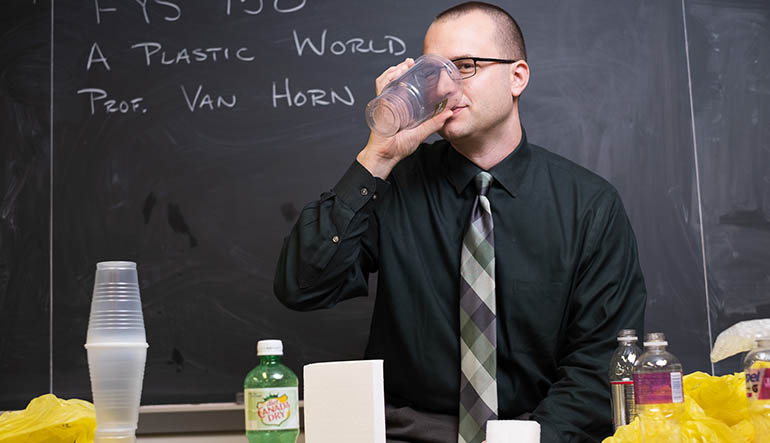The future is plastics
Ryan Van Horn ’04, associate professor of chemical and biomolecular engineering, has received a second National Science Foundation (NSF) grant supporting his research relating to plastics. Recently he talked about the research conducted through his previous NSF grant that ran from June 2018 through April 30 and what lies ahead.
 What were you trying to achieve with this research project?
What were you trying to achieve with this research project?
We are trying to understand how the behavior of biodegradable plastic can be changed. Most differences in plastic products are determined by differences in the chemical structure of the molecules. Our studies focus on one particular chemical structure that has variability in how physical interactions between molecules occur. We are interested in how the molecules interact, whether those interactions can be manipulated, and how changes in those interactions result in different properties.
What’s the relevance of this in your field?
Through this work, we may be able to broaden the applicability of certain plastics. For example, plastic bags and plastic milk bottles are made of plastic with the same chemical structure. The difference in physical interaction makes one more flexible and one more rigid. Our work may provide opportunities to change the degradation rate of a particular plastic. This could be useful in the field of drug delivery or even sustainable plastics.
What did the research involve?
There was a lot of experimental lab work using a variety of analytical equipment. Most of the work was performed by undergraduate students. The research is relatively simple to perform but complicated to understand, so it is easy to involve students from first-years through senior theses.
What were the results?
We have found that making plastic materials under different conditions—casting from different liquids to make films or heating/cooling at different rates and temperatures—results in changes in the structure (physical interactions). This is promising for making materials with different behavior. My new NSF grant will support continuing this work and to begin studying the degradation behavior.
How does this research impact your teaching?
Since I teach courses in materials, and biomaterials in particular, it is easy to demonstrate concepts that we are learning in class using work that occurs in my lab. It’s also good to demonstrate how versatile plastics are from chemical make-up all the way through behavior and properties.
Where does the research go from here?
My new NSF grant will focus on understanding the physical processes in a bit more detail, determining other techniques for manipulating the physical interactions, and moving toward measuring changes in this behavior. The two important processes for degradation are water infiltration and material loss. The changes in physical interactions influence both of these. We will study how to tailor these for fast or slow degradation rate and for fast and slow drug release.
1 Comment
“One word….plastics”